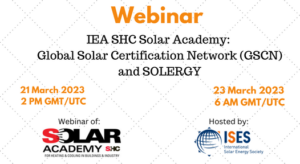Certification and labelling of new collector types
May 2, 2023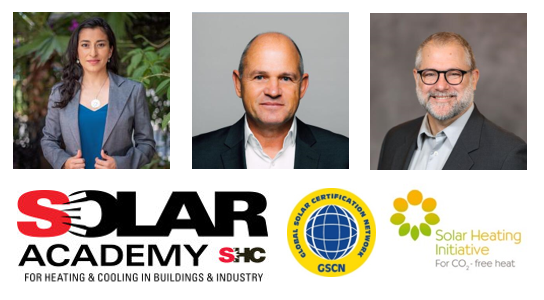
GSCN and the Solergy label are continuing to grow together. More than a year ago, the Global Solar Certification Network and the Solar Heating Initiative, which developed the Solergy label, agreed to cooperate. In the recent IEA SHC Academy webinar the two initiatives gave an update on the expansion of their activities. Here, we bundle the answers from the experts related to the certification and labelling of new collector types and the related costs and procedures. (From left): Marisol Oropeza (Head of Marketing of the Global Solar Heating Initiative), Stephan Fischer, Group Leader for Component and System Testing at the Institute for Building Energetics, Thermotechnology and Energy Storage (IGTE) at the University of Stuttgart, and Shawn Martin, Manager of the Solar Rating and Certification Corporation (SRCC). A special offer enables collector manufacturers who use the Solergy label to become GSCN members for one year free of charge. The recording of the webinar is available online.
Graphics: IEA SHC Solar Academy Webinar
If a collector manufacturer holds a Solar Keymark certificate for its collector, joins the GSCN and then wants to enter the US American market. How does this work?
Martin: Usually SRCC would need an application. The good news is that if you hold a Solar Keymark certificate which was issued recently, we can usually utilize the test report without additional testing. I say usually, because there are package systems such as special types of thermosiphon unit that fall under ISO 9459-5 instead of ISO 9806. But in most cases SRCC will simply need to review the system for compliance with US codes and standards. And then from there we’re happy to proceed to certification usually without the need for additional testing.
How about the Solergy label for PVT collectors? Is it comparable to the one for standard water heating collectors?
Oropeza: Indeed, we have recently launched the label for PVT collectors. It exists for two temperature ranges, 25 °C and a combination of 25 and 50 °C. The electrical output of the panels is considered on the right hand side of the label. This promotes the element to a much higher class.
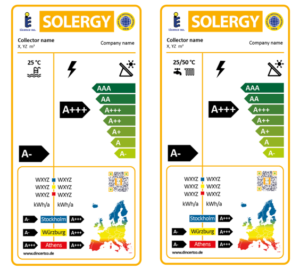
New Solergy label for PVT collectors in two different variants. If the solar power production of the PVT collector is taken into account, the element increases by a few classes. Source: Solar Heating Initiative
How high are the costs for the Solergy label?
Oropeza: Manufacturers or suppliers of collectors can apply for the Solergy label if they already have a Solar Keymark certificate for their collector. Then it is not that costly. We charge EUR 250 per collector type for which a Solergy label is issued. For example, roughly EUR 500 for one collector in two sub-types. A part of the payment goes to the test lab, another part to the Solar Heating Initiative and a further part is transferred to GSCN. So it’s quite accessible because actually it’s based on a previous certification process. The issuing costs will recur depending on the validity of the Keymark certificate.
Fischer: Solar Keymark certificates are valid for five years and can be renewed once for another five years. But after 10 years retesting is required.
Is the fee for membership of GSCN independent from the Solergy label?
Fischer: In principle it´s separate. The annual fee for a collector manufacturer to become a member of the GSCN is 250 EUR. But we recently combined the offers. So all manufacturers who already have a Solergy label will receive one year GSCN membership for free.
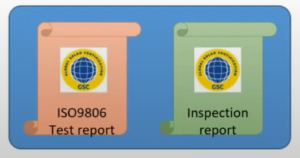
What is the difference between a test report and a certification report?
Fischer: The test report is issued for a product that has been tested, in this context usually a solar collector. It compiles the data resulting from the test procedure described in ISO 9806 for a specific sample product. A certification report is related to the production line and checks ongoing compliance with the standard. The aim here is to check whether production is designed in such a way that reproducible quality can be expected and that the collector is produced in the same way as the sample that was used for the testing.
Since 2012 we have a global collector standard called ISO 9806. Which aspects are part of the current revision of ISO 9806?
Fischer: Several topics we are looking at during the revision of the standard have to do with new and special collector types.
- First of all, regarding PVT collectors, we would like to introduce the so-called gross solar yield, which is the sum of the gross thermal yield and gross electrical yield.
- We are also working on a test procedure for air-brine collectors. These collectors are basically heat exchangers to the ambient temperature which capture solar irradiation as well. They are used as heat sources for heat pumps. Here we are discussing the inclusion of night-time tests and also tests with operating temperatures below ambient temperature, to cover the full range of operating modes of such collectors.
Another important topic is related to lifecycle analysis, reparability and material use. These aspects are not defined yet within the standard and we want to include at least an informative appendix in the revision of ISO 9806.
What is the timeline for the ISO 9806 revision?
Fischer: Publication of the new ISO 9806 is expected during 2024. The Solar Keymark scheme usually takes over the revised ISO 9806 with one year transition time. At SRCC this process takes a bit longer since they need to update the SRCC standard to adopt the new ISO 9806 version.
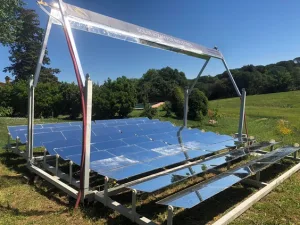
Photo: Solatom
How about plans to adapt the certification to concentrating collector technologies?
Fischer: Actually, this is already in place. ISO 9806 allows for testing and certification of concentrating collectors. Nevertheless, we face some problems with regard to testing the collectors in labs, as they are often fairly large. But ISO 9806 allows for in-situ testing. This means that we can go into the field and do the testing onsite. Another difficulty is that some of the quality and reliability tests are not well-suited to concentrating collectors, such as the stagnation test. A concentrating collector will always move the mirror field out of the sun if the temperature in the receiver rises to a certain maximum. But in principle, it’s possible to do the testing and the certification as well.
Martin: We have already certified various concentrating collectors. We offer traditional OG 100 certification for concentrating collectors tested in the lab as well is in-situ testing. But we also have another service called Site-Specific Certification. This is useful when concentrating collectors are produced in large quantities for one particular project and the manufacturer is not necessarily intending to make them available as an off-the-shelf product in exactly in the same form. Site-Specific Certification then allows for in-situ testing of the collectors and results in OG-100 certification that is valid for this particular project. And unlike traditional certifications, it is a one-time effort that does not need to be renewed. But it can only be used at that one project site. Other installations of the same collector at other sites would need to go through the full certification process once again.
Websites of organisations mentioned in this news article:
Global Solar Certification Network: https://gscn.solar/
Solar Heating Initiative: https://solar-heating-initiative.com/
IEA Solar Heating and Cooling Programme: https://www.iea-shc.org/
Solar Academy: https://www.iea-shc.org/solar-academy
Solar Rating and Certification Corporation: http://www.solar-rating.org
Institute for Building Energetics, Thermotechnology and Energy Storage: http://www.igte.uni-stuttgart.de
Solergy label: https://www.dincertco.de/din-certco/en/main-navigation/products-and-services/certification-of-products/environmental-field/collector-output-label/

